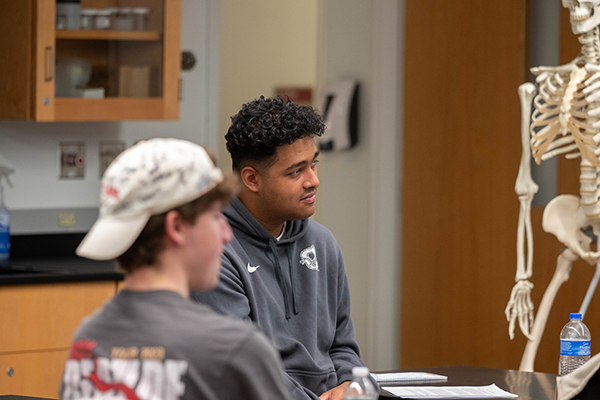
09/10/2024
In late August, seven new SUNY Cortland students from diverse backgrounds arrived on campus a week early to immerse themselves in a variety of science, technology, engineering and mathematics (STEM) experiences.
The new first-year, sophomore and transfer students were all selected for the Central New York Louis Stokes Alliances for Minority Participation (LSAMP) program, which since 2021 has used a $1.99 million grant from the National Science Foundation intended to increase the recruitment, retention and graduation of students in a range of STEM disciplines.
“When you’re a high school student, you really don’t know what research is about,” explained Christa Chatfield, professor of biological sciences, and SUNY Cortland’s LSAMP Program co-director, about the introductory week of activities and workshops and later programming to get them involved in STEM research. “That’s our goal, to help them gain that understanding as soon as possible in their careers.”
Sophomore Michael Kosowski of Bellmore, N.Y., knew he was interested in the science of the human body and wondered if that interest would extend to other branches of science.
“I have always liked medicine, and I was originally interested in disease and virology, which was influenced by movies,” the biomedical sciences major said.
“I hoped by doing the LSAMP program I could become more interested in nature, research and other parts of science, and that most definitely happened.”
The LSAMP group consisted of students in STEM majors who had self-identified as being from historically underrepresented groups as well as students who were recommended by a faculty member. Cortland’s summer workshops helped these individuals build fundamental skills, such as study habits, time management and writing in the sciences, while introducing them to each other, the university and future professional collaborators.
Over the past three years, the program at SUNY Cortland has helped 16 aspiring STEM scholars complete an authentic, eight-week summer laboratory research experience paired with a faculty mentor, according to Chatfield.
During the introductory week before classes, the future biologists, geologists, chemists and mathematicians toured key academic buildings including Memorial Library, Sperry Center and Old Main for introductions to the resources they’ll need to succeed in STEM.
That week, they also:
- observed wolves and foxes in the wild and learned more about their key role in ecosystems at the Wolf Mountain Nature Center in nearby Chenango County
- visited the Tully, N.Y., laboratories of Syracuse pharmaceutical products research company Ichor Life Sciences
- sampled effective ways to present their research data in a Memorial Library computer lab, led by Associate Professor of Biological Sciences Andrea Davalos
- explored the geology, biology and chemistry of Fillmore Glen State Park in Moravia, N.Y., with a park ranger
- hosted a New York State Department of Environmental Conservation official to discuss internships in the outdoors, conservancy and geology
LSAMP, created to build preparedness and community in STEM among underrepresented students, is led by Ithaca College, Chatfield noted. The lead institution each fall hosts an alliance-wide seminar for networking and sharing of scientific results in poster sessions, talks and professional development sessions featuring faculty from underrepresented backgrounds. SUNY Cortland’s close collaboration through 2025 also includes the SUNY College of Environmental Science and Forestry, Elmira College, Hobart and William Smith Colleges, Herkimer College and Tompkins Cortland Community College.
Each LSAMP participants’ highly unusual capstone experience — completed before entering their second Cortland year — consists of a paid fellowship with on campus housing to conduct eight weeks of summer research mentored by a faculty member in their chosen discipline.
“It really seems to create a curiosity that they want to explore research opportunities early on, but that’s really the goal of the program,” said Chatfield, who herself has mentored two of the summer research students.
“It’s a way to create an entry into the research experience so they can find what they are excited about. Even if that first lab that we place them in is not what they are really excited about, at least they have the confidence to seek out other opportunities.”
One former LSAMP student has completed multiple scientific studies with two different professors and presented their findings at a national conference, Chatfield said. This past summer, three LSAMP scholars completed their laboratory or fieldwork investigations.
Isabell Faydalla of Howard Beach, N.Y., a senior biology major minoring in chemistry and psychology, worked with SUNY Cortland Assistant Professor of Biological Sciences Santanu Banerjee at Syracuse University to study the effect of BPA, a chemical commonly found in plastics, on the seizure behavior of zebrafish larvae.
“Participating in this program has led to an astonishing amount of self-growth in such a short period of time,” said Faydalla, who graduates next May. “The program also builds such a welcoming community of students who are going through the same successes, obstacles and even failures.”
Marissa Mc Lean of Plattsburgh, N.Y., a conservation biology major who will graduate next spring, launched her research to study flower tube length and width evolution with a summer trip to Kew Gardens in London, United Kingdom, with Assistant Professor Elizabeth McCarthy. This fall, in the Introduction to Biology lab where she serves as teaching assistant, Mc Lean’s photographed images will be measured by students. Mc Lean will then analyze the findings for her study.
“My experience as part of the LSAMP program has exposed me to more than I could have imagined when it comes to doing strictly scientific research,” Mc Lean said. “I have learned about the professional science world that will allow me to determine my future.”
For a slideshow of this year's orientation classes, select an image below.



